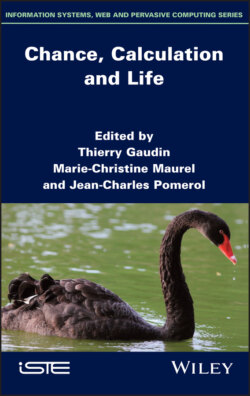Chance, Calculation and Life

Реклама. ООО «ЛитРес», ИНН: 7719571260.
Оглавление
Группа авторов. Chance, Calculation and Life
Table of Contents
List of Illustrations
Guide
Pages
Chance, Calculation and Life. A Journey Beyond Appearances
Preface
A long cultural tradition
A like-minded original project
A regularly supported action
Introduction
Acknowledgments
In memoriam
Reference
1. Classical, Quantum and Biological Randomness as Relative Unpredictability
1.1. Introduction
1.1.1. Brief historical overview
1.1.2. Preliminary remarks
1.2. Randomness in classical dynamics
1.3. Quantum randomness
1.4. Randomness in biology
1.5. Random sequences: a theory invariant approach
1.6. Classical and quantum randomness revisited. 1.6.1. Classical versus algorithmic randomness
1.6.2. Quantum versus algorithmic randomness
1.7. Conclusion and opening: toward a proper biological randomness
1.8. Acknowledgments
1.9. References
2. In The Name of Chance
2.1. The birth of probabilities and games of chance
2.1.1. Solutions
2.1.1.1. The Prince of Tuscany’s problem for Galileo
2.1.1.2. Chevalier de Méré’s problem for Pascal
2.1.2. To what end?
2.2. A very brief history of probabilities
2.3. Chance? What chance?
2.4. Prospective possibility
2.4.1. LLN + CLT + ENIAC = MC
2.4.2. Generating chance through numbers
2.4.3. Going back the other way
2.4.4. Prospective possibility as master of the world?
2.5. Appendix: Congruent generators, can prospective chance be periodic? 2.5.1. A little modulo n arithmetic
2.5.2. From erratic arithmetic to algorithmic randomness
2.5.3. And, the winner is... Mersenne Twister 623
2.6. References
3. Chance in a Few Languages
3.1. Classical Sanskrit
3.2. Persian and Arabic
3.3. Ancient Greek
3.4. Russian
3.5. Latin
3.6. French
3.7. English
3.8. Dice, chance and the symbolic world
3.9. References
4. The Collective Determinism of Quantum Randomness
4.1. True or false chance
4.2. Chance sneaks into uncertainty
4.3. The world of the infinitely small
4.4. A more figurative example
4.5. Einstein’s act of resistance
4.6. Schrödinger’s cat to neutrino oscillations
4.7. Chance versus the anthropic principle
4.8. And luck in life?
4.9. Chance and freedom
5. Wave-Particle Chaos to the Stability of Living. 5.1. Introduction
5.2. The chaos of the wave-particle
5.3. The stability of living things
5.4. Conclusion
5.5. Acknowledgments
5.6. References
6. Chance in Cosmology: Random and Turbulent Creation of Multiple Cosmos
6.1. Is quantum cosmology oxymoronic?
6.2. Between two realities – at the entrance and exit – is virtuality
6.3. Who will sing the metamorphoses of this high vacuum?
6.4. Loop lament
6.5. The quantum vacuum exists, Casimir has met it
6.6. The generosity of the quantum vacuum
6.7. Landscapes
6.8. The good works of Inflation
6.9. Sub species aeternitatis
6.10. The smiling vacuum
7. The Chance in Decision: When Neurons Flip a Coin
7.1. A very subjective utility
7.2. A minimum rationality
7.3. There is noise in the choices
7.4. On the volatility of parameters
7.5. When the brain wears rose-tinted glasses
7.6. The neurons that take a vote
7.7. The will to move an index finger
7.8. Free will in debate
7.9. The virtue of chance
7.10. References
8. To Have a Sense of Life: A Poetic Reconnaissance
8.1. References
9. Divine Chance. 9.1. Thinking by chance
9.2. Chance, need: why choose?
9.3. When chance is not chance
9.4. When chance comes from elsewhere
10. Chance and the Creative Process. 10.1. Introduction
10.2. Chance
10.3. Creation
10.4. Chance in the artistic creative process
10.5. An art of the present moment
10.6. Conclusion
10.7. References
11. Epigenetics, DNA and Chromatin Dynamics: Where is the Chance and Where is the Necessity? 11.1. Introduction
11.2. Random combinations
11.3. Random alterations
11.4. Beyond the gene
11.5. Epigenetic variation
11.6. Concluding remarks
11.7. Acknowledgments
11.8. References
12. When Acquired Characteristics Become Heritable: The Lesson of Genomes
12.1. Introduction
12.2. Horizontal genetic exchange in prokaryotes
12.3. Two specificities of eukaryotes theoretically oppose horizontal gene transfer
12.4. Criteria for genomic analysis
12.5. Abundance of horizontal transfers in unicellular eukaryotes
12.6. Remarkable horizontal genetic transfers in pluricellular eukaryotes
12.7. Main mechanisms of horizontal genetic transfers
12.8. Introgressions and limits to the concept of species
12.9. Conclusion
12.10. References
13. The Evolutionary Trajectories of Organisms are Not Stochastic. 13.1. Evolution and stochasticity: a few metaphors
13.2. The Gouldian metaphor of the “replay” of evolution
13.3. The replay of evolution: what happened
13.4. Evolutionary replay experiments
13.5. Phylogenies versus experiments
13.6. Stochasticity, evolution and extinction
13.7. Conclusion
13.8. References
14. Evolution in the Face of Chance. 14.1. Introduction
14.2. Waddington and the concept of canalization
14.3. A stochastic model of Darwinian evolution. 14.3.1. Redundancy and neutral networks
14.3.2. A toy model
14.3.3. Mutation-selection algorithm
14.4. Numerical results. 14.4.1. Canalization
14.4.2. Target selection
14.4.3. Neighborhood selection
14.5. Discussion
14.6. Acknowledgments
15. Chance, Contingency and the Origins of Life: Some Historical Issues
15.1. Acknowledgments
15.2. References
16. Chance, Complexity and the Idea of a Universal Ethics1
16.1. Cosmic evolution and advances in computation
16.2. Two notions of complexity
16.3. Biological computations
16.4. Energy and emergy
16.5. What we hold onto
16.6. Noah knew this already!
16.7. Create, protect and collect
16.8. An ethics of organized complexity
16.9. Not so easy
16.10. References
List of Authors
Index. A, B
C
D, E
F, G
H, I
L
M, N
O, P
Q, R
S
T, U
V, W
WILEY END USER LICENSE AGREEMENT
Отрывок из книги
Series EditorJean-Charles Pomerol
.....
As we can guess from the discussion of the four sequences above, randomness can be refuted, but cannot be mathematically proved: we can never be sure that a sequence is “random”, there are only forms and degrees of randomness (Calude 2002; Downey and Hirschfeldt 2010).
Finally, note that similarly to randomness in classical dynamics, which was made intelligible by Poincaré’s negative result, AIT is also rooted in a negative result: Gödel’s incompleteness theorem. As recalled above, a random sequence is a highly incomputable sequence. That is, algorithmic randomness is in a certain sense a refinement of Gödel’s undecidability, as it gives a fine hierarchy of incomputable sets that may be related, as we will hint below, to relevant forms of randomness in natural sciences.
.....